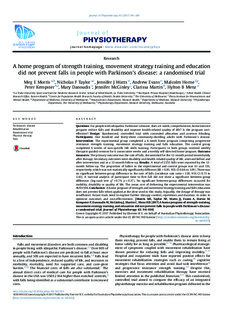| dc.contributor.author | Morris, Meg E. | |
| dc.contributor.author | Taylor, Nicholas F. | |
| dc.contributor.author | Watts, Jennifer J. | |
| dc.contributor.author | Evans, Andrew | |
| dc.contributor.author | Horne, Malcolm | |
| dc.contributor.author | Kempster, Peter | |
| dc.contributor.author | Danoudis, Mary | |
| dc.contributor.author | McGinley, Jennifer | |
| dc.contributor.author | Martin, Clarissa | |
| dc.contributor.author | Menz, Hylton B. | |
| dc.date.accessioned | 2019-03-01T12:01:09Z | |
| dc.date.available | 2019-03-01T12:01:09Z | |
| dc.date.issued | 2017 | |
| dc.identifier.citation | Meg E Morris, Nicholas F Taylor, Jennifer J Watts, Andrew Evans, Malcolm Horne, Peter Kempster, Mary Danoudis, Jennifer McGinley, Clarissa Martin, Hylton B Menz, A home program of strength training, movement strategy training and education did not prevent falls in people with Parkinson’s disease: a randomised trial, Journal of Physiotherapy, Volume 63, Issue 2, 2017, Pages 94-100, ISSN 1836-9553 | nb_NO |
| dc.identifier.uri | http://hdl.handle.net/11250/2588253 | |
| dc.description.abstract | Questions
For people with idiopathic Parkinson’s disease, does a 6-week, comprehensive, home exercise program reduce falls and disability and improve health-related quality of life? Is the program cost-effective?
Design
Randomised, controlled trial with concealed allocation and assessor blinding.
Participants
One hundred and thirty-three community-dwelling adults with Parkinson’s disease.
Intervention
The experimental group completed a 6-week home program comprising progressive resistance strength training, movement strategy training and falls education. The control group completed 6 weeks of non-specific life skills training. Participants in both groups received weekly therapist-guided sessions for 6 consecutive weeks and a weekly self-directed home program.
Outcome measures
The primary outcome was the rate of falls, documented for the 12-month period immediately after therapy. Secondary outcomes were disability and health-related quality of life, assessed before and after intervention and at a 12-month follow-up.
Results
A total of 2255 falls were reported by the 12-month follow-up. The proportion of fallers in the experimental and control groups was 61 and 72%, respectively, which was not statistically significantly different (RR = 0.85, 95% CI 0.66 to 1.09). There was no significant between-group difference in the rate of falls (incidence rate ratio = 1.58, 95% CI 0.73 to 3.43). A survival analysis of participant time to first fall did not show a significant between-group difference (log-rank test χ2 = 0.79, p = 0.37). No significant between-group differences occurred for mobility, disability or quality of life. The mean cost of delivering the experimental intervention was AUD1596.
Conclusion
A home program of strength and movement strategy training and falls education does not prevent falls when applied at the dose used in this study. Arguably, the dosage of therapy was insufficient. Future trials need to explore further therapy content, repetitions and duration, in order to optimise outcomes and cost-effectiveness. | nb_NO |
| dc.publisher | Journal of Physiotherapy | nb_NO |
| dc.rights | Attribution-NonCommercial-NoDerivatives 4.0 Internasjonal | * |
| dc.rights.uri | http://creativecommons.org/licenses/by-nc-nd/4.0/deed.no | * |
| dc.subject | Parkinson’s disease | nb_NO |
| dc.subject | rehabilitation | nb_NO |
| dc.subject | randomised trial | nb_NO |
| dc.subject | physical therapy | nb_NO |
| dc.subject | falls | nb_NO |
| dc.subject | nevrologiske lidelser | nb_NO |
| dc.title | A home program of strength training, movement strategy training and education did not prevent falls in people with Parkinson’s disease: a randomised trial | nb_NO |
| dc.type | Journal article | nb_NO |
| dc.source.pagenumber | 94-100 | nb_NO |
| dc.source.volume | 63 | nb_NO |
| dc.source.journal | Journal of Physiotherapy | nb_NO |
| dc.source.issue | 2 | nb_NO |
| dc.identifier.doi | https://doi.org/10.1016/j.jphys.2017.02.015 | |

